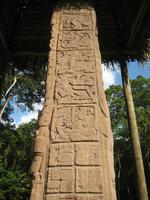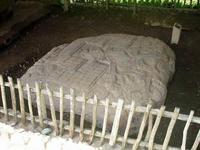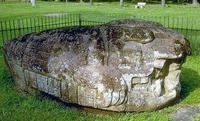You are in: Central America -> Guatemala -> Archaeological Park ... , and traditional search or Image Gallery will yield results of this site only
Archaeological Park and Ruins of Quirigua
| Site number: | 149 |
|
| Type of site: | Cultural | |
| Date: | 2nd c.AD-8th c. | |
| Date of Inscription: | 1981 | |
| Location: | South America, Guatemala, Guatemala, Department of Izabal | |
Up to 75 images are shown here. Click on each for more details or on Image Gallery for more images.
| Description: | Quirigua has been inhabited since the 2nd century A.D. Whilst under the reign of Cauac Sky (723–84) it became the capital of an autonomous and prosperous state. The present ruins of Quirigua reveal a number of exceptional 8th-century monuments, an impressive series of carved stelae as well as sculpted calendars – all of which constitute a crucial source for the study of Mayan civilization. --WHMNet paraphrase from the description at WHC Site, where additional information is available. | |
| Quiriguá is an ancient Maya site in the Izabal department of Guatemala. Quiriguá is a medium sized site along the lower Motagua river, with the ceremonial center heart of the site about 1 km from the left bank of the river. The city's period of occupation seems to correspond to the length of the Maya Classic period; the site being occupied by 200, construction on the acropolis begun about 550, a great boom of grander construction beginning in the 700s with all construction evidently halting about 850. Quiriguá's boom in the 700s was no doubt tied to the military victory by Quiriguá's king Cauac Sky (also known to the Ancient Maya as "Butz Tiliw" and "K’ak’ Tiliw Chan Yo'at") over Copán in 738, when the most famous king from Copán, Uaxaclajuun Ub'aah K'awiil or "18-Rabbit", was defeated, captured and then sacrificed in the grand Plaza at Quiriguá. Before this Quiriguá was probably a vassal state of Copán, afterwards the situation was reversed. The amount of grand ceremonial architecture is perhaps rather small for a site of Quiriguá's importance, but the site remains very impressive thanks largely to its wealth of sculpture, some of the finest of ancient Mesoamerica. This includes unusually huge stelae elaborately carved from single blocks of stone, the largest being 10 meters (35 feet) tall and weighing some 60,000 kg (65 tons), the Stela E, the largest of the Maya civilization. In addition to the tall vertical stelae, the site has a number of boulders elaborately sculpted into the forms of mythological animals; these sculptures are referred to as Zoomorphs. There are also various altars and sculptures used as decoration in the facades of buildings. As a whole, the artistry of the sculptures is not quite so good as the best found at Palenque and Copán; most Quiriguá monuments have a grand formal monumentallity that is rather stiff compared to the naturalistic grace of the art of those other sites. A few Quiriguá monuments, however, show exceptional artistry. Probably the finest of these are Stela D from 766 which has extravagant full-figure anthropomorphic versions of Maya hieroglyphics on one side, and Zoomorph P (which explorer Maudslay nicknamed The Great Turtle), from 736, which are masterpieces of Mesoamerican art. Stela C depicts the date 13.0.0.0.0 4 Ahaw 8 Kumk'u (August 13, 3114 BC), the beginning of the 5th. Maya Era. --Wikipedia. Text is available under the Creative Commons Attribution-ShareAlike License. | ||
| Source: | http://whc.unesco.org/en/list/149 | |
| Reference: | 1. UNESCO World Heritage Center, Site Page. | |


































